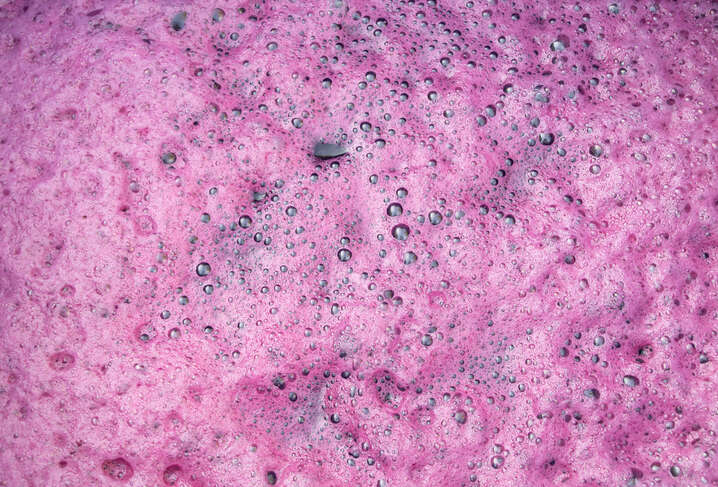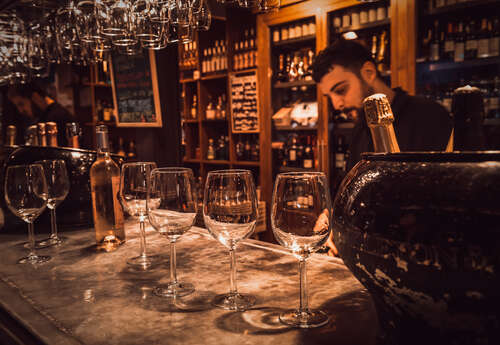
Stuart Walton explores the long European tradition of drinking unfinished wine shortly after harvest—a practice rich in cultural significance.
At what stage may a wine be regarded as finished? When the bottle is sealed, or released to the market, as far as the winemaker is concerned. The knowledgeable buyer will need a sliding scale of definitions of completeness: two years from the harvest and the Viognier is probably not going to do much more for you, while the Barolo has only just entered the initial phase of a 20-year hibernation. These variable measures, quite arcane to the uninitiated, become second nature to true disciples of Bacchus.
There has always been another side to Bacchus, however. Nobody planning an orgiastic dance intends to provision it from the dustiest, most slumberous regions of the cellar. The wine of the moment is what’s needed, the newest vintage, hot off the press, seething with ebullience, cruddy as a fast-flowing river, an unstable brew only halfway through its metamorphosis. More poignant than the question of when the wine is finished, is the matter of when it starts.
Young and raw
In most of the European heartlands, it has been traditional to drink some of the wine young and raw, at a point when it is still technically only half-wine. The Heurige, Austrian taverns where the new white wine is served soon after the general vinification has begun, derive their very name from the indication that the wine of “this year” is their bill of fare. Jugs of opaque young Federweisser—literally, “feathery-white” from its yeast suspensions—pass along the tables in an atmosphere of inebriate conviviality, toasts and benedictions rising to the ceiling beams amid the gorgeous cacophony of Schrammel bands, a scene whose eighteenth-century roots still joyously show.
The Federweissenfest of Germany’s Mosel valley takes place in November, when Rieslings still in a state of obstreperous semi-ferment are served with caraway-scented onion cake (Zwiebelkuchen) to rosy-cheeked patrons securely bundled against the raking cold. In the Czech region of Moravia, the annual burčákfest at Znojmo reaches back to a much earlier historical paradigm than the Viennese Heurige, with armored jousting and comic juggling among the diversions. Even on the Côte d’Or, where small productions intended for long ageing have endowed the wine with some of the greatest covetability in the connoisseurial world, Nuits-St-Georges hosts a Fête du Vin Bourru, a Gallic October-fest of wines in ferment, the boisterous junior Pinots earning their name (bourru means surly, coarse, gruff).
Closer to juice
Most of this wine tastes more like the sweet grape juice to which it is still biochemically nearer, but that is half its appeal. Like innocuous-looking cocktails full of fruit pulp, there is an unquantifiable sting in the tail. Any sensitivity to the microbiological instability of vinifying wine will be teased out of its consumers in the jittery stomach and thudding head of remorse, even as the B-vitamin soup is nourishing their cells, but the greatest hazard lies in simply not knowing how much alcohol you are consuming. Eight or nine per cent by volume may be typical for Federweisser, but 12-13% is not unknown. In certain contexts, if the afternoon and evening roll on and the tavern is warm and gemütlich, the alcohol level could be creeping imperceptibly up between wheezes of the accordion.

Festivals such as these may seem to brush antithetically against the grain of everything woven into the cultural meanings of wine, which gained its dignity in antiquity through its perceived tendency to improve and perfect itself, to become more valuable and sought-for, as it matured with keeping. The surly wines of the harvest festivals have never heard of maturity, being only halfway along from the turbid squirt of the wine presses, and a long way from the kind of finishing school that involves wooden barrels and months of patience. In this, they are more genuinely the people’s wine, a volatile substance already partly armed with the alcohol it hasn’t yet been trained in the use of, seducing its celebrants into the reckless liberties its proprietary god once ritually demanded.
Thick and fizzing
Unfinished wine reminds its growers and their neighbors that, before the market works its far more mysterious purposes on a bottled agricultural product, before it even gets as far as the bottle, wine belongs to them and the patches of earth from which they draw their sustenance. Its autumn parties are the first and last hurrah of the idea that, when it stops being grape juice, the first thing it becomes is alcohol. Siphoned into shared jugs in November’s watery sunshine, it will never be as rudely, crudely, the intoxicant it is as at this tender but rambunctious moment—indeed, it will never be anything else at all. Not every Nuits-St-Georges has the chance to go through a vin bourru stage. It will be imbibed in appreciative siplets when it—and we—have grown into our maturity. Drunk thick and fizzing from the vat, though, it insists that the model and origin of life’s pleasures is youth.






